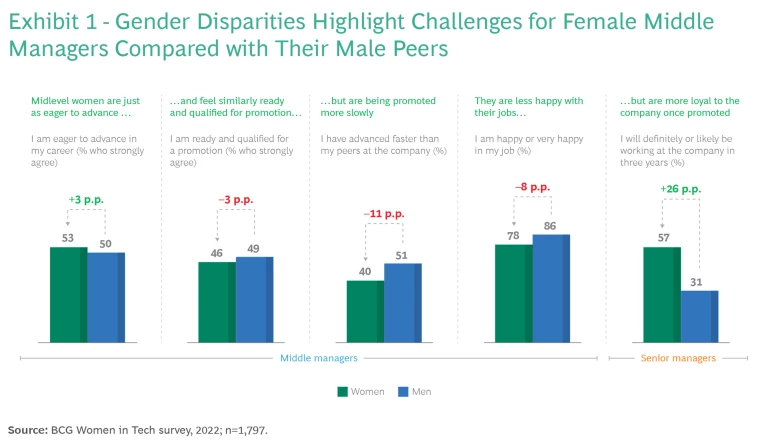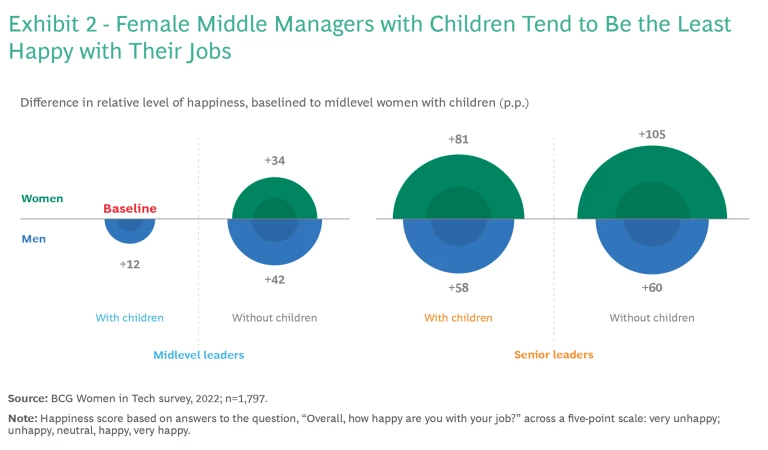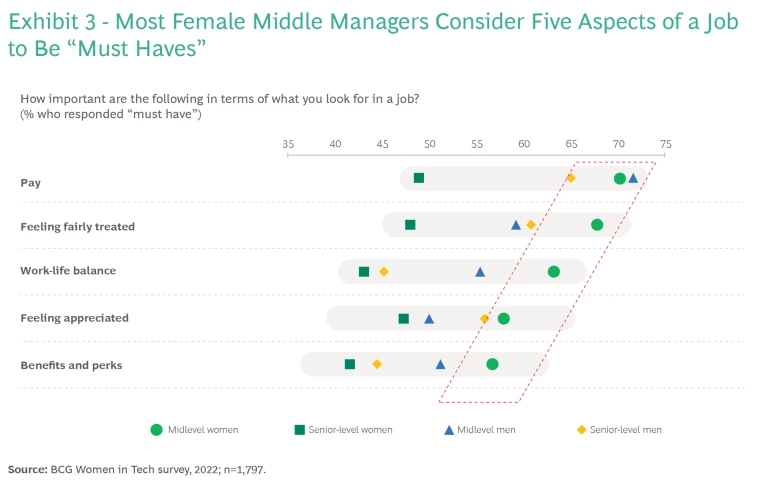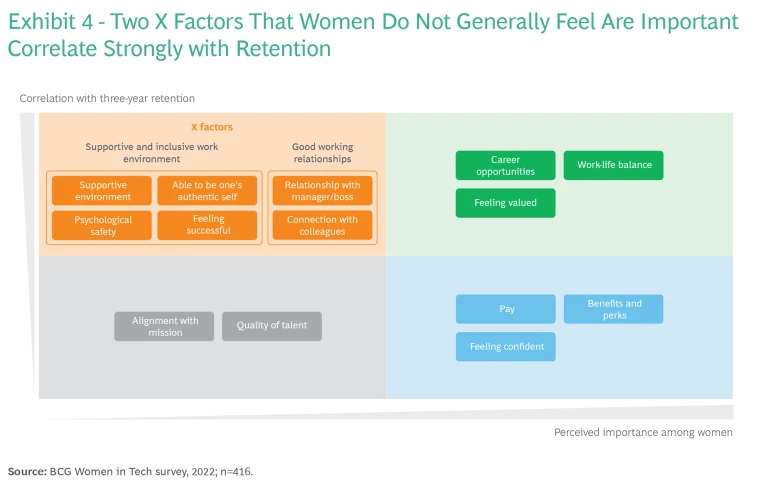As tech companies continue the waves of layoffs that began in 2022, they will likely exacerbate an ongoing problem: the lack of women on leadership teams. The industry is already starting at a disadvantage, with the share of women in middle management and senior leadership roles remaining stubbornly below 30%. The ongoing layoffs—many targeted at midlevel managers—will compound the challenge.
We recently surveyed approximately 1,800 midlevel and senior leaders in the US to identify the key barriers to advancement for women in tech. (See “Our Research Methodology.”) This research is the latest in a series of analyses about women in technology. One central finding this year is that midlevel management is a key juncture for job satisfaction in women’s tech careers—and one where many organizations may be falling short because of a set of overlooked “X factors.”
Our Research Methodology
Midlevel managers make up the pipeline of future leaders in tech, and our research shows how challenges for women result in not just a glass ceiling but a broken ladder. “I have seen many of the women I admire in tech leave the industry,” said one female senior executive at a global technology company. “It’s important for me to stay and keep the seat I have fought so hard for, especially as certain pockets of tech have gotten worse in gender parity.”
The good news? Although senior women leaders in technology aren’t represented in equal numbers with men, they report the highest happiness and motivation levels, and the lowest retention risk, of any group we looked at. In other words, if companies can retain women through their time as middle managers, they have a real chance of seeing those women stay and thrive, rising to the top levels of the organization.
The Critical Juncture in Middle Management
Our survey showed the clear disparities in job satisfaction and overall happiness between men and women across different levels of seniority:


- Midlevel women report lower levels of happiness in their jobs. Both women and men report lower happiness levels at the middle-management level compared with more senior colleagues, but midlevel women are significantly less happy than their male peers. At the same time, midlevel women are as eager as men to advance in their careers. (See Exhibit 1.)
- Having children compounds the challenge. In general, having children reduces job happiness levels for all groups, likely because of the challenges involved in balancing responsibilities at work and at home. (See Exhibit 2.) In some cases, companies assume that women want to slow their career progression once they have kids. As one female tech executive told us, “Decisions are sometimes made for women coming back from maternity leave with the unconscious bias that they prefer a less challenging role, without actually asking for their perspective.” Both male and female senior leaders—whose children are more likely to be older and more independent—are the happiest with their jobs. Among midlevel managers, men with kids are happier than their female peers with kids by about 10 percentage points. However, we found that midlevel women without children are likewise less happy than their male counterparts, suggesting that additional factors are contributing to the gender disparity in job happiness.
- Midlevel women are stalling out in their careers. Female middle managers are just as motivated to give their best as male middle managers—and feel similarly ready and qualified for promotion—but they are less likely to be advancing quickly in their careers. Only 40% of midlevel women said they are advancing faster than their peers—a significantly lower share than men and senior-level women. The pace of advancement evens out by the time men and women reach senior management, but women who don’t feel that they’re getting a fair shot may not stay long enough to benefit.
The X Factors in Satisfaction and Retention
In our survey, we asked about the importance of various aspects of a job, such as compensation, work-life balance, career opportunities, and a supportive working environment. We found that both male and female middle managers rank the same five factors—pay, feeling fairly treated, work-life balance, feeling appreciated, and benefits and perks—as the top five in importance (albeit in a slightly different order). But the share of midlevel women who feel that these factors are “must haves” is close to 10 percentage points higher in all cases except for pay, where the spread is slightly smaller. (See Exhibit 3.) A possible explanation is that women in this group are generally less happy at work, so they are more demanding about what makes a job worth having.

We also compared the factors that women say are important with those that actually correlate with retention. (See Exhibit 4.) For example, good pay and benefits were cited as important, but neither meaningfully improves retention. Conversely, our analysis revealed two X factors that women don’t generally identify as important but that correlate strongly with retention:
- A supportive and inclusive work environment, including a sense of safety and the freedom to be oneself on the job
- Good working relationships with managers and colleagues

Diverse Leadership Can Help
Notably, respondents at companies with more diverse senior leadership teams (across all dimensions of diversity) show higher satisfaction with respect to the entire set of X factors. This finding may not be surprising, but it underscores a critical area for companies to get right. Diversity at the top sends a signal throughout the organization, reflecting a commitment to equitable hiring and to a bias-free, safe environment. More balanced leadership teams strengthen that organizational culture and foster an environment conducive to advancing women into senior leadership. As a growing body of research shows, this results in better performance overall—not just improved inclusion and rates of attrition but improved business performance as well.
Unfortunately, most leadership teams in tech are still overwhelmingly male and white. Without diverse leadership, companies need to take other measures to improve the working environment for women at midlevel management and above—from public commitments to diversity, equity, and inclusion to the training of senior and midlevel leaders on how to ensure a bias-free environment.
The Power of Mentorship and Sponsorship
Our survey findings point to specific steps that companies can take to help midlevel women advance. For example, women who rise to senior roles have typically built up strong relationships and networks within their organizations—not just in the natural course of their work but also through formal sponsorship and mentorship programs.
Such programs can be an effective way to increase the satisfaction of female middle managers, and they have a multiplier effect. Get them right, and they can make a meaningful difference in the retention and advancement of midlevel women. Get them wrong, and the company loses out on an opportunity to address the challenges that matter at scale. So it’s important to understand what works—and why. Sponsorship and mentorship programs are not new ideas; many companies have them in place. Our research shows, however, that employees who are advancing more slowly than their peers are less satisfied with these offerings and less likely to participate. And this is especially true of women, whose satisfaction with such programs is 10% to 15% lower than that of men at the same level.
Sponsorship and mentorship programs can be an effective way to increase the satisfaction of female middle managers, and they have a multiplier effect.
Sponsors and mentors are distinct roles that serve very different purposes. Both mentors and sponsors provide advice and guidance, but sponsors also serve as advocates. That means speaking up—and even pounding the table—on behalf of the employees they sponsor to ensure that they are considered for promotions, new assignments, and plum projects. We have found that satisfaction with these programs is highest when midlevel leaders—men as well as women—have both a mentor and a sponsor, with the sponsor relationship being the most important.
A Playbook for Change
On the basis of our survey findings and interviews with senior executives—including many who have built diverse leadership pipelines—we have identified some concrete actions that companies can take to advance women into leadership positions in tech.
Convey the importance of both sponsors and mentors. Sponsors and mentors complement each other but can’t replace each other. It’s critical to have both, with the sponsor relationship being the most important.
Make leaders accountable for investing time in sponsorship. Companies need to actively support sponsors, and sponsors need to commit the time required to actively support the employees they sponsor. Organizations that lack an established culture of sponsorship may need to create incentives to ensure that the necessary work gets done and that participants enjoy the promised benefits.
Tailor programs to the needs of the organization. Every company has its own culture and is at its own maturity levels in terms of DEI. There is no silver bullet to solving the diversity challenge; solutions need to be tailored to the specific needs and challenges of the organization.
Companies need to actively support sponsors, and sponsors need to commit the time required to actively support the employees they sponsor.
Ensure that the burden isn’t falling disproportionately on women leaders. We found that female senior leaders tend to mentor and sponsor larger numbers of employees compared with male senior leaders. Much of explanation may lie in the concerns of both senior men and midlevel women about the relationship between female employees and male mentors and sponsors. For example, midlevel women can be reluctant to speak freely about their experiences if they suspect that male mentors don’t fully appreciate the challenges that they face. In fact, roughly half of male mentors and sponsors in tech functions report that they have difficulty understanding those challenges. Training can mitigate some of these problems—for example, by educating men in the gender-related biases and inequities historically experienced by women in the workplace.
Create alternative pathways to leadership, such as job sharing. Alternative career pathways through tandem leadership models—with two female employees sharing a single role—offer advantages to the organization and to the executives who participate. Both women gain valuable work experience and the chance to show that they have the necessary skills, while also maintaining a reasonable work-life balance. And companies get to develop more women on the leadership track.
There’s a clear business reason to increase rates of retention and advancement for midlevel women in tech: doing so leads to better financial and operational performance. But it’s also simply the right thing to do. The lack of women on senior leadership teams is a significant problem, and it won’t go away until companies take specific steps to improve. But our work in this area points to straightforward, proven measures that tech leaders can implement—starting today.
The authors thank Jean Lee, Jie Ren, Jessica Siew, Zixuan Wang, Shuting Feng, Matt Witalec, and Nick Putnam for their research and analysis support.



